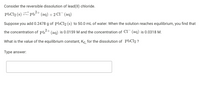
Chemistry
10th Edition
ISBN: 9781305957404
Author: Steven S. Zumdahl, Susan A. Zumdahl, Donald J. DeCoste
Publisher: Cengage Learning
expand_more
expand_more
format_list_bulleted
Question

Transcribed Image Text:Consider the reversible dissolution of lead(II) chloride.
PbCl2 (s) Pb²+
(аq) + 2 CI (аq)
Suppose you add 0.2478 g of P6C12 (s) to 50.0 mL of water. When the solution reaches equilibrium, you find that
the concentration of Pb²+ (aq) is 0.0159 M and the concentration of Cl (aq) is 0.0318 M.
What is the value of the equilibrium constant, Kc, for the dissolution of PbCl2 ?
Type answer:
Expert Solution
This question has been solved!
Explore an expertly crafted, step-by-step solution for a thorough understanding of key concepts.
This is a popular solution
Trending nowThis is a popular solution!
Step by stepSolved in 2 steps

Knowledge Booster
Learn more about
Need a deep-dive on the concept behind this application? Look no further. Learn more about this topic, chemistry and related others by exploring similar questions and additional content below.Similar questions
- I had 1.0 mL of 1.0M CoCl2 in a test tube. I put it into boiling water. [Co(H2O)6]2+, [CoCl4]2- Equilibrium temperature effect. Effect of heat What happens to the equilibrium? Use this equation in your explanation... 4Cl_ (aq) + [Co(H20)6]2+(aq)---[CoCl4]2-(aq)+ 6 H20 (l) I did this in class. The color change was very slow but it changed from a burgandy to fushia.arrow_forwardExpress the equilibrium constant for the following reaction. N2(g) + 3H2(g) ⇒ 2NH3(g) K = K = K = K = K= [N₂][H₂]1/3 [NH 3]1/2 [NH 3]6 [N₂]³[H₂]⁹ [NH 3]2 [N₂][H₂]³ [N₂][H₂]³ (NH3)2 (NH3]1/2 [N2][H₂]1/3arrow_forwardFor the following reaction and its equilibrium constant, determine whether the position of equilibrium lies towards reactants, towards products, or somewhere reasonably close to the middle (intermediate). NH3(aq) + HBrO(aq) ⇒ NH4*(aq) + BrO (aq) K = 5.0arrow_forward
- At 25 °C, an aqueous solution has an equilibrium concentration of 0.00217 M for a generic cation, A+(aq), and 0.00109 M for a generic anion, B2−(aq). What is the equilibrium constant, ?sp, of the generic salt A2B(s)?arrow_forwarda) Balance the following equation and write it below: Fe (s) + Mg3(PO,), (aq) → Fe;(P 0,), (aq) + Mg(s) b) If you added 134.2 grams of Iron to an excess of Mg,(PO,)2, how many moles of Iron have you added? c) Assuming the reaction is reversible, in which direction would the equilibrium shift if Fe was removed from the solution (left, right, or no change?) d) What type of reaction is this?arrow_forwardChapter 12 part 1 #12arrow_forward
- Write the mathematical expression for the equilibrium constant and using concentrations < 1 M, makeup two sets of concentrations that describles a mixture of A,B, and C at equilibrium.arrow_forward8. You mix a 200.0-mL sample of a solution that is 1.5 X 10-³ M in Cu(NO3)2 with a 250.0-mL sample of a solution that is 0.20 M in NH3. After the solution reaches equilibrium, what concentration of Cu²+ (aq) remains? For [Cu(NH3)4]²+, Kf = 1.7 x 1013 me thatarrow_forward6. Give the equilibrium constant for the following reaction. 2PB1, (g) + 3Cl,(s) 2PCI;(g) + 3Br,(g)arrow_forward
- The equilibrium constant of the reaction 2C02 = 2C0+02 is 1.08. If the concentrations of CO and O2 is 0.86 M and 0.54 M, respectively, what is the concentration of carbon dioxide?arrow_forwardA student determines that an aqueous solution that contains 0.474 M potassium hypochlorite and 0.180 M hypochlorous acid, also has an H30* concentration of 1.89x10-8 M. Based on these data, calculate the value of the equilibrium constant K for the equilibrium: HCIO(aq) + H2O =H30*(aq) + ClO(aq) Calculate K as is usually done, omitting the solvent, water, from the expression for K: Karrow_forward
arrow_back_ios
arrow_forward_ios
Recommended textbooks for you
 ChemistryChemistryISBN:9781305957404Author:Steven S. Zumdahl, Susan A. Zumdahl, Donald J. DeCostePublisher:Cengage Learning
ChemistryChemistryISBN:9781305957404Author:Steven S. Zumdahl, Susan A. Zumdahl, Donald J. DeCostePublisher:Cengage Learning ChemistryChemistryISBN:9781259911156Author:Raymond Chang Dr., Jason Overby ProfessorPublisher:McGraw-Hill Education
ChemistryChemistryISBN:9781259911156Author:Raymond Chang Dr., Jason Overby ProfessorPublisher:McGraw-Hill Education Principles of Instrumental AnalysisChemistryISBN:9781305577213Author:Douglas A. Skoog, F. James Holler, Stanley R. CrouchPublisher:Cengage Learning
Principles of Instrumental AnalysisChemistryISBN:9781305577213Author:Douglas A. Skoog, F. James Holler, Stanley R. CrouchPublisher:Cengage Learning Organic ChemistryChemistryISBN:9780078021558Author:Janice Gorzynski Smith Dr.Publisher:McGraw-Hill Education
Organic ChemistryChemistryISBN:9780078021558Author:Janice Gorzynski Smith Dr.Publisher:McGraw-Hill Education Chemistry: Principles and ReactionsChemistryISBN:9781305079373Author:William L. Masterton, Cecile N. HurleyPublisher:Cengage Learning
Chemistry: Principles and ReactionsChemistryISBN:9781305079373Author:William L. Masterton, Cecile N. HurleyPublisher:Cengage Learning Elementary Principles of Chemical Processes, Bind...ChemistryISBN:9781118431221Author:Richard M. Felder, Ronald W. Rousseau, Lisa G. BullardPublisher:WILEY
Elementary Principles of Chemical Processes, Bind...ChemistryISBN:9781118431221Author:Richard M. Felder, Ronald W. Rousseau, Lisa G. BullardPublisher:WILEY

Chemistry
Chemistry
ISBN:9781305957404
Author:Steven S. Zumdahl, Susan A. Zumdahl, Donald J. DeCoste
Publisher:Cengage Learning

Chemistry
Chemistry
ISBN:9781259911156
Author:Raymond Chang Dr., Jason Overby Professor
Publisher:McGraw-Hill Education

Principles of Instrumental Analysis
Chemistry
ISBN:9781305577213
Author:Douglas A. Skoog, F. James Holler, Stanley R. Crouch
Publisher:Cengage Learning

Organic Chemistry
Chemistry
ISBN:9780078021558
Author:Janice Gorzynski Smith Dr.
Publisher:McGraw-Hill Education

Chemistry: Principles and Reactions
Chemistry
ISBN:9781305079373
Author:William L. Masterton, Cecile N. Hurley
Publisher:Cengage Learning

Elementary Principles of Chemical Processes, Bind...
Chemistry
ISBN:9781118431221
Author:Richard M. Felder, Ronald W. Rousseau, Lisa G. Bullard
Publisher:WILEY